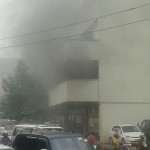Kampala – As one walks up from the main road to the stone quarrying site at Jinja Kalori in Kawempe, on the outskirts of Kampala city, a magnificent rock emerges out of the foreground view. The closer you get at the site, the more you can see dark fumes in the air.
The women seated on the ground, hit rocks to get it into small sizes while the men pile sand unto the wheelbarrows, managing the fire in the rocks and shoveling stone dust at another level.
Nassazi Jane, a mother of five has spent 11 years doing this job to be able to fend for her family. The different kinds of stones are sold in terms of the carriers. A wheelbarrow goes for Shs7000 while a pickup at Shs100,000.
Currently their work has been slowed down due to the reduced use of tyres to burn the rocks. The tyres were cheaper to get and also fastens the pressure to crack down the rocks with a lot of moist easily.
“The tyres were bought at Shs300-500 compared to firewood bought at Shs5000 each log and this would increase the workload of hitting the stones but now with the use of firewood, there is reduced pressure on the rocks and hence less work load,” Nassazi said.
Nassazi says they minimally use the tyres because it has affected some of their colleagues and children when they inhale the fumes. “People complain about having problems in their lungs, sneezing black mucus and eventually have to seek medication. We have been advised not to use tyres again for our health benefit.”
The ordeal started from a Haji Kasozi’s child from Kano Enterprises, in the neighborhood, who suffered breathing problems due to the poisonous fumes. This created tension in neighborhood and prompted them to start using firewood.
Dr. Ibrahim Twinomujuni, a clinician at Makerere University Hospital said “Carbon monoxide (CO) is a most dangerous gas emitted by burning tyres and causes death by poisoning if inhaled for long and in big amounts. It is particularly dangerous because it is colourless, non-irritant and odourless”.
It is produced by the incomplete burning of organic substances particularly in homes by gas cookers, wood, coal or paraffin, and in vehicle exhaust fumes and in this case burning of tyres”.
Twinomujuni adds that CO binds to haemoglobin reducing the oxygen-carrying capacity of the blood. Some of the symptoms of carbonmonoxide poisoning include; headache, nausea and vomiting, and drowsiness, hyperventilation and shivering.
Mrs. Sarah Kagwa, a native in the area, says the soot from the tyres goes to the roof and when it used to rain, they received dirty water.The soot also spoils wall paintings, washed clothes on the hang lines.
A house on the stone site spoiled by soot
Prevention and treatment
The first step in treating CO poisoning is to remove the patient from the source of exposure. The airway, breathing and circulation must be adequately maintained and oxygen given as soon as possible.
Twinomujuni advised the workers at the quarry to mask their eyes and mouths to avoid particles falling into the eyes, and gloves to protect the hands from sharp edged rocks.
Apart from the scorching sun, the workers face cuts from sharp stones, reduced work load in terms of slowing down the process to work on the rocks hence reduced income. The chemicals also affect their lungs thus causing chest pain.
However even after government officials including the local councilor at Kawempe visited the place; nothing has been done to help out the working conditions of the workers.






